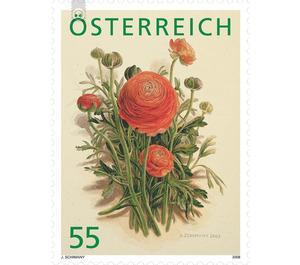flowers - Austria / II. Republic of Austria 2008 - 55 Euro Cent
Theme: Flora
| Country | Austria / II. Republic of Austria |
| Issue Date | 2008 |
| Face Value | 55.00 |
| Edition Issued | 200,000 |
| Printing Type | offset |
| Stamp Type | Commemorative |
| Item Type | Stamp |
| Chronological Issue Number | 2096 |
| Chronological Chapter | OOS-OE2 |
| SID | 117136 |
| In 58 Wishlists | |
Judith Schimany studied painting with Anton Lehmden at the Academy of Fine Arts in Vienna. She received the Theodor Körner Prize and the Prize of the Foundation Sinaide Ghi in Rome and has made numerous exhibitions at home and abroad, for example at the Vienna Art Fair, Dorotheum, the Gallery Infeld Vienna, Gallery at the Düssel in Düsseldorf, gallery Hartmann in Munich, Artisart Gallery in Maastricht, and finally in the Old Town Hall in Vienna. From the oil painting, in watercolor and in the etching of equal skill she uses every technique for a reproduction of the reality between dream image and objectivity. Their themes are overgrown gardens, floodplains, rocks and southern coasts, as well as everyday things like rocks, withered flowers, coral and shells, tropical landscapes and fresh flowers. Her view of nature reveals influences of Moritz Michael Daffinger and Rudolf von Alt. The technique of pure watercolor, as first brought to fruition by the English of the 18th century - Thomas Girtin, William Turner and others - is based on painting with transparent colors without the use of opaque white. The fascinating thing about this technique is its simplicity. The watercolor "Ranunkel" is 30 x 35 cm and painted on 600g heavy handmade paper with watercolor paint. The plant should dominate the room in its typical shapes and colors and in its opulence, so that you can recognize the special about it. In her painting, the painter wants to draw attention to the beauty and diversity of nature, which can also be found in apparently everyday things. The variations in shapes and colors, even in a small flower, surpass human imagination many times over, one can always find new aspects in them. It is an attempt to understand the nature of nature and to create something ideal itself that lifts one above pure materialism. In addition, she wants to reflect the hope and joy of life that she herself feels through creation.


